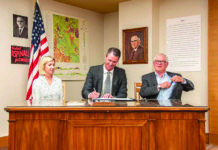by Alec Williams
It has been over 17 years since the shooting at Columbine High School and 2017 will mark the 10 year anniversary of the Virginia Tech shooting. The number of recorded school shootings in the United States has more than tripled since the 1980’s.
High school and university administrators have to be increasingly more familiar with these issues, now having to consider prevention along with education. Rather than wait to investigate after such an incident, university campuses have begun implementing action plans in case of such a threat. The following is an outline of CMU’s action plan.

The shooting begins
CMU’s current active protocol, described by Vice President of Student Services John Marshall, begins with a 911 phone call placed by someone on campus witnessing the shooting. Grand Junction 911 dispatch would then alert emergency responders to the location.
CMU President Tim Foster said himself and administrators such as Marshall would be immediately alerted.
“I mean, we have an emergency contact list, we’re both on that, as well as a number of other folks. And then it comes down to how active you’re going to be. What are you going to do?” Foster said. “Because what we don’t need to do is get in the middle of their command and direction because they know more than we do.”
Next, CMU administration would begin sending out text message alerts to students, faculty and staff.
“Some students don’t want – and some faculty and some staff don’t want to share their cell numbers with us, so we can’t text them,” Foster said. It is anticipated that first responders would be in route at this point.
The U.S. Department of Homeland Security reported in 2013 that the average length of a school shooting is 12.5 minutes and the average response time for law enforcement is 18 minutes.
Law enforcement can take a long time to arrive on a scene, but with recent technological additions the university can effectively be turned into a fortress with the press of a button.
University lockdown
“Depending on the situation, if it’s warranted, you would see buildings start locking down immediately,” Marshall said.
CMU uses this technology to remotely lock academic and administrative buildings down.
“So, when you think about every building you walk into you see those little card swipes, that’s the university center, that’s houston [hall], that’s dominguez [hall], that’s escalante [hall], that’s the library, that’s every residence hall. It’s virtually every campus building,” Marshall said.
Many of these locks are included in each academic building’s rooms, and in the event of a shooting or similar emergency, the protocol states that those doors would automatically lock down.
Despite these advancements, President Foster explained that safety was not the first thought when designing and building the campus.
“You gotta do it for the function first and foremost and then you know, it’s not like we designed all sorts of automatic this and automatic that and safety zones and those sorts of things,” Foster said.
Law enforcement officers are sent in to provide back up, but CMU does have a frontline defense already on campus.
Frontline Defense
CMU employs active Grand Junction police officers to serve on campus during the academic year. Depending on the day and time, there can be up to five officers working on campus.
Primarily, officers will be on campus weekdays during school hours, usually the early morning until the early afternoon. Wednesdays and Thursdays officers are most active and prevalent, while no officers are usually stationed on campus Sundays.
“I mean, you see some universities have campus police and this institution used to have campus police, but you get into all sorts of Well, what level can you train them? Do you want them carrying firearms? Does the local police department? How are they going to communicate? How are they going to interact? Who’s going to bump into who? And so, given their capacity it’s much better for us and it raises the level of response just to have the local Grand Junction police department,” Foster said.
A study held by the U.S. Department of Justice during the 2011-12 academic year found that 95 percent of the 905 public university campuses with more than 2,500 students operated their own campus law enforcement agency.
CMU would fit into the five percent who do not. And of that five percent, 18 percent of public institutions rely on local police departments, like CMU and the Grand Junction police department.
Over the past decade discussions and protests have been held across U.S. college campuses on the subject of why a firearm is allowed on campus, CMU has not been exempt.

Guns on campus
CMU and subsequently the state of Colorado allow concealed firearms on campuses. This is a policy all universities in this state and others like Kan., Wis., Miss., Ore., Texas, Utah, and Idaho are required by law to follow. An active discussion is held and is continued to be held by proponents and opponents to the policy.
“I can tell you that this is just not an issue. […] I mean, a lot of people are trying to look at carry-states, non-carry-states and the data doesn’t really tell you anything,” Marshall said.
“Because you’re looking at false negatives and false positives in a lot of ways.” Marshall was referring to shooting rates compared to their concealed-carry policies, and the data remains inconclusive.
A school that has a concealed-carry allowance has not been considered more or less likely to have a school shooting.
“I’m not sure somebody who’s gonna come do something untowards on campus stops and thinks ‘I wonder how many concealed carries are here,’” Foster said.
CMU attempts to prevent a shooter from stepping foot onto campus, but what is done for those threats could already be on campus.
Students of concern
Many school shootings involve a shooter who is a former or current student, which causes administrators to look within for a threat. CMU’s prevention involves a group called the “students of concern,” wherein members of faculty and staff will alert the CMU administration when there is a student a professor has concerns about.
This group is similar to what Virginia Tech and other institutions have set in place. Marshall could not disclose how many students they were concerned about at any given time, but will receive alerts often enough.
“Regularly, yeah,” Marshall said. “We have an inter-disciplinary team that meets weekly across the university and that includes law enforcement, it include mental health, it includes academics and athletics, and housing, and student life and all these areas to try and make sure that if a student is, you know, struggling through some difficult issues that we’re able to respond quickly and get them the support that they need.”
The unthinkable
Prevention is an active role that has become expected of university and K-12 school administrators as school shooting rates have increased, but prevention can and has failed on many occasions.
“Gosh, you can never predict how one of those things unfolds and it seems like every time we read about one of those incidences, or turn on the television, there’s some new twist that we have to think about the unthinkable,” Marshall said.



